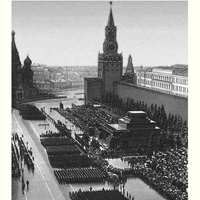Учебное пособие Кривцова, Кочетова. Учебное пособие для обучающихся по техническим и экономическим направлениям подготовки бакалавров
 Скачать 1.91 Mb. Скачать 1.91 Mb.
|
Victory Parade 1945 June 24, 1945 at 10:00 a.m. on the Red Square, Moscow, a Victory Parade took place to commemorate the victory of the Soviet Union over Nazi Germany in the Great Patriotic War. The parade was received by the First Deputy People's Commissar of Defense and Deputy Supreme Commander, the commander of the 1st Belorussian Front, Marshal of the Soviet Union, G. K. Zhukov. In charge of the parade was the commander of the 2nd Belorussian Front, Marshal of the Soviet Union, K. K. Rokossovsky. In late May and early June in Moscow was held intensive preparations for the parade. In early June all the participants of the parade, wearing a new dress uniform, proceeded to the pre workout. To participate in the ceremony regiments were formed and trained representing each front which was in force at the end of the war, led by commanders of the fronts. It was decided to bring the Red flag from Berlin, hoisted over the Reichstag. The formation of the parade was in accordance with the general line of the fronts in force – from right to left. The favorite military marches were chosen for each regiment. Following the regiments of the fronts and the Navy, the combined column of Soviet soldiers entered Red Square. They were carrying, dropped to the ground, 200 banners of Nazi troops, defeated on the battlefield. These banners were thrown to the foot of the mausoleum as a sign of a crushing defeat of the aggressor. At 23 p. m. the sky over Moscow lit up with searchlights, there were hundreds of balloons in the air, and from the ground the volleys of fireworks with colorful lights were heard. The highlight of the holiday was the cloth with the image of the Order of "Victory", which appeared in the sky in the spotlight. The next day, June 25, the Grand Kremlin Palace hosted a reception in honor of the Victory Day parade. After a grand celebration in Moscow, upon the suggestion of the Soviet government and the Supreme Command, in September 1945, there was held a small parade of allied troops in Berlin, which was attended by Soviet, American, British and French troops.
Adjectives. Degrees of comparisonВ английском языке качественные прилагательные имеют три степени сравнения:
Степени сравнения прилагательных могут быть образованы тремя способами:
Степени сравнения односложных прилагательныхОдносложные прилагательные образуют сравнительную степень путем прибавления к положительной степени суффикса –er, а превосходную степень – прибавлением суффикса –est. Перед существительным, определяемым прилагательным в превосходной степени, всегда стоит определенный артикль the.
Степени сравнения двухсложных и многосложных прилагательныхБольшинство двухсложных прилагательных и прилагательных состоящих из трех и более слогов, образуют сравнительную степень при помощи слова more – более, а превосходную степень при помощи слова most – наиболее. More и most всегда ставятся перед прилагательными в положительной степени (т.е. основной форме).
Обратите внимание, что двухсложные прилагательные, оканчивающиеся на –er, -y, -ow, -le чаще образуют степени сравнения, при помощи суффиксов – er, -est.
| ||||||||||||||||||||||||||||||||||||
